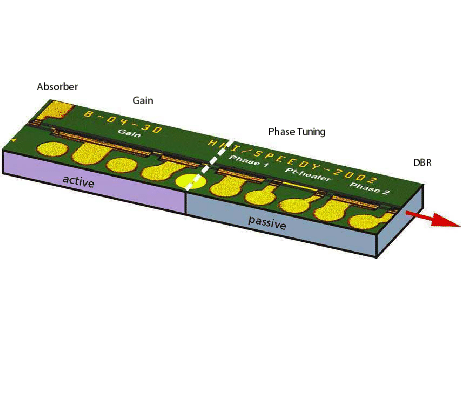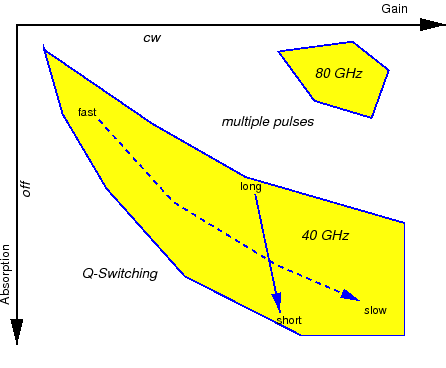 |
|
|
|
[Contents] | [Index] |
Collaborator: U. Bandelow (FG 1), A. Vladimirov
(FG 2)
Cooperation with: B. Hüttl, R. Kaiser, (Fraunhofer-Institut für Nachrichtentechnik, Heinrich-Hertz-Institut (HHI), Berlin)
Supported by: Terabit Optics Berlin (project B4)
Description:
Mode-locked semiconductor lasers have attracted considerable research interest for many years, for their high speed potential as well as the possible generation of intense pulses. Together with our partners, we are aiming at an optical data transmission at rates of 40 GHz. A typical device under consideration is sketched in Figure 1.
 |
In a mode-locked laser, a spatio-temporal structure develops across the entire device, which has to be properly accounted for. An adequate description is given by the traveling wave equations (TWE)
for the slowly varying amplitudes E+(z, t) and E-(z, t) of the forward and back traveling waves, respectively. The boundary conditions are E-(L, t) = rLE+(L, t) and E+(0, t) = r0E-(0, t) at the facets of the laser.| (4) | |||
| - i |
= | - i |
(5) |
 |
Typical simulation results are schematically drawn in Figure 2. As indicated there, other effects occur outside the mode-locking areas which hinder applications. These effects influence smoothly the mode-locking behavior already within the shaded areas, resulting in an increasing amplitude noise, if one approaches the boundaries. Above the 40-GHz area, we discovered a region where a two-pulse (instead of one) scenario appears.
To our surprise, we observed the stabilization of the two pulses when we decreased the absorption even more and increased the gain slightly, thereby approaching the upper right area in Figure 2 called 80 GHz. In this situation the two pulses keep the maximum distance in the resonator and counter-propagate through it. This is indicated by the completely correlated output pulses at the two end facets, drawn in the upper Figure 3, with a repetition frequency of 80 GHz. The latter is twice the roundtrip frequency, such that we can call it harmonic mode locking. The surprising thing is that there is no specific geometrical construction as, e.g., a ring resonator or a colliding pulse scheme which would support this type of mode locking: The pulses meet simply somewhere in the phase tuning section without specifically gaining from that. The harmonic mode locking appears to be self-starting and is stable over a finite range of parameters. So far, this was our first observation from numerical simulations with the TWE model. Later in 2004, this phenomenon has, indeed, been measured at the HHI with autocorrelation techniques. The measured autocorrelation trace is depicted in the lower Figure 3 and displays a periodic signal with a repetition frequency of 80 GHz, which corresponds to our prediction.
![\makeatletter
\@ZweiProjektbilderNocap[v]{0.5\textwidth}{80GHz_ldsl}{80GHz_auto_hhi}
\makeatother](img764.gif) |
Even more, the harmonic mode locking has been measured in the same region of parameters as predicted by the theory, cf. shaded ``80 GHz'' areas in Figure 2 and in Figure 4.
For a qualitative analysis, we use in addition lumped differential-delay models [2], similar to the Lang-Kobayashi treatment of lasers with external feedback. When deriving these models, we do not use the approximations of small gain and loss per cavity round trip and weak saturation. Therefore, our models are capable of describing mode locking in the parameter range of semiconductor lasers. In the first, ring cavity model, the equations governing the time evolution of the electric field amplitude a(t) at the entrance of the gain section, saturable gain g(t), and saturable loss q(t) take the form of delay differential equations, [2, 3],
The second, linear cavity model, assumes that both gain and saturable absorber sections are thin as compared to the pulse width. In the case when the absorber section is situated close to one of the two cavity mirrors, this model takes the form:|
|
(9) |
|
|
(10) |
|
|
(11) |
References:
|
|
|
[Contents] | [Index] |